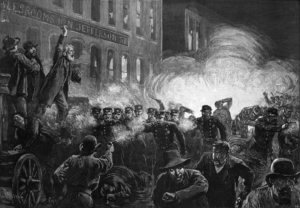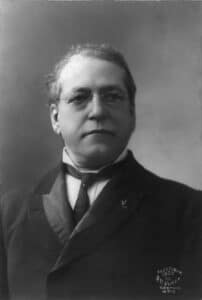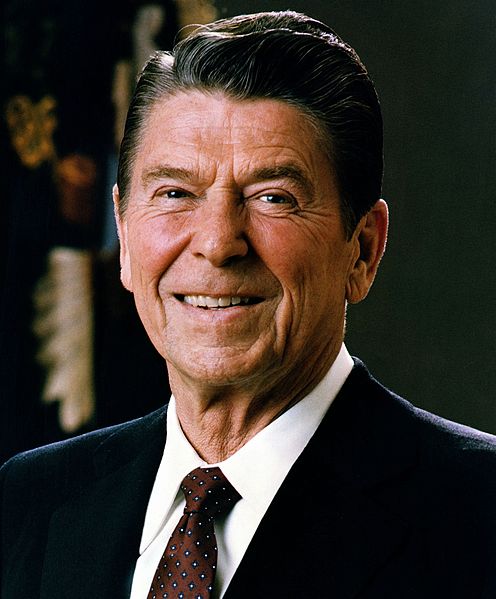Things like unions, collective bargaining, and minimum wages seem to be pretty standard today (but not without their fare share of controversy). But the basic labor protections that these organizations and policies are meant to protect have not always been embedded in the idea of the United States; the history of the American Federation of Labor is proof of that. So how did the American Federation of Labor (AFL) come to be? And what are its impacts for U.S. history? Keep reading to learn more about this important topic for the APUSH exam.
How did the American Federation of Labor (AFL) get started?

In order to understand the history of the AFL, we need to go back to another event: the Haymarket Square Riot. On May 4, 1886, a group of socialists and anarchists met at Haymarket Square in Chicago; they were protesting police violence that occurred the day before at a strike at the McCormick factory.
There’s still some ambiguity as to who started the riot by throwing a bomb; most historians believe it was someone connected with the anarchist group. However, there is consensus in the historical community that the eight individuals who were tried and quickly punished for the riot – four hanged for their alleged connection to the crime – were innocent.
The event at Haymarket Square was organized by the Knights of Labor, and because of the violence and a general anti-unionism sentiment popular at the time, the membership for the Knights declined dramatically. Here enters the American Federation of Labor, and one of its charismatic leaders, Samuel Gompers.
Who was Samuel Gompers?

Gompers immigrated to the United States from London in the midst of the Civil War with his family. By age 27, he was running the family cigar-making business.
In 1886, a few months after the Haymarket Riot, Gompers met with other trade organization leaders to create the American Federation of Labor.
Gompers’ leadership was not without its own controversies; for example, he eventually made the decision to exclude unskilled workers from membership in the American Federation of Labor. And across the board, Gompers advocated more conservative strategies, which stood in stark contrast to the tactics that more radical unions had taken before him.
“The ground-work principle of America’s labor movement has been to recognize that first things must come first,” Gompers explained in 1911. “Our mission has been the protection of the wage-worker, now; to increase his wages; to cut hours off the long workday, which was killing him; to improve the safety and the sanitary conditions of the workshop; to free him from the tyrannies, petty or otherwise, which served to make his existence a slavery.”
Although Gompers was much more conservative than other labor organizers – which earned him a positive reputation among businessmen – he still opposed things such as company-organized unions. More radical members may have been allowed to participate in AFL organizing, but the purpose of the AFL was not to change American society. Rather, Gompers wanted to “keep it simple” by focusing on material gains for workers in the form of increased wages and a shorter work week.
As Gompers stated in his 1893 speech before the International Labor Congress entitled “What does Labor Want?”
Render our lives while working as safe and healthful as modern science demonstrates it is possible. Give us better homes is just as potent a cry to-day as when Dickens voiced the yearnings of the people of a generation ago…We want more school houses and less jails; more books and less arsenals; more learning and less vice; more constant work and less crime; more leisure and less greed; more justice and less revenge; in fact, more of the opportunities to cultivate our better natures, to make manhood more noble, womanhood more beautiful and childhood more happy and bright (Source: The Gompers Papers).
Who could be in the American Federation of Labor?
As historian Michael K. Honey made clear in his book Southern Labor and Black Civil Rights, the AFL admitted a wide range of individuals when they were just starting out (including women and people of color). However, they grew more exclusive, barring African Americans and effectively becoming an organization for white men.
Historian Philip Rubio also found that the AFL supported the renewing of the 1882 Chinese Exclusion Act and actively branded products made by AFL members to discourage individuals from buying products made by Chinese workers.
What kinds of questions will I be asked about the American Federation of Labor on the APUSH exam?
Source: Glencoe Multiple Choice Quiz
1. A major feature of the program of the American Federation of Labor was its emphasis on
A. gender equity between male and female industrial workers.
B. reforming and altering the capitalist system so that workers would own part of the corporations they worked for.
C. immediate gains for its members, such as higher wages, shorter hours, and better working conditions.
D. mass organization of all laborers skilled, unskilled, and agricultural.
E. creating a pathway for women into the work force.
2. The significance of the Haymarket Square incident in 1886 was that
A. unions won their demand for an eight-hour day.
B. the American socialist movement received a great boost.
C. the use of Pinkerton guards as strikebreakers was outlawed.
D. it led to federal intervention in labor union matters.
E. it heightened a hysterical wave of fear of anarchism and immigration and its alleged connection with unionism.
Correct Answers:
1. C
2. E




